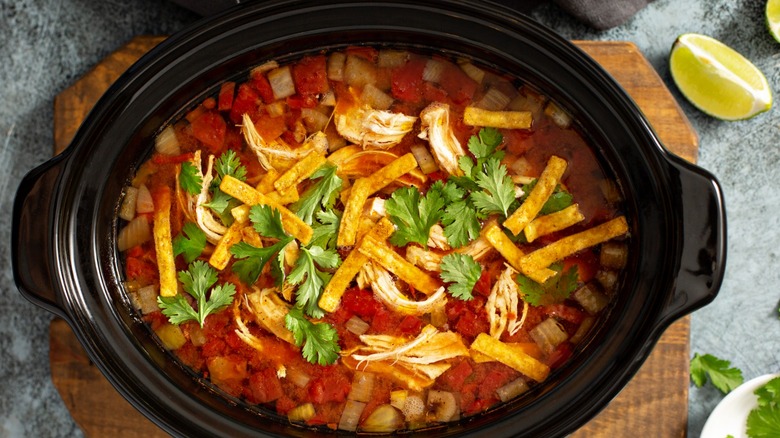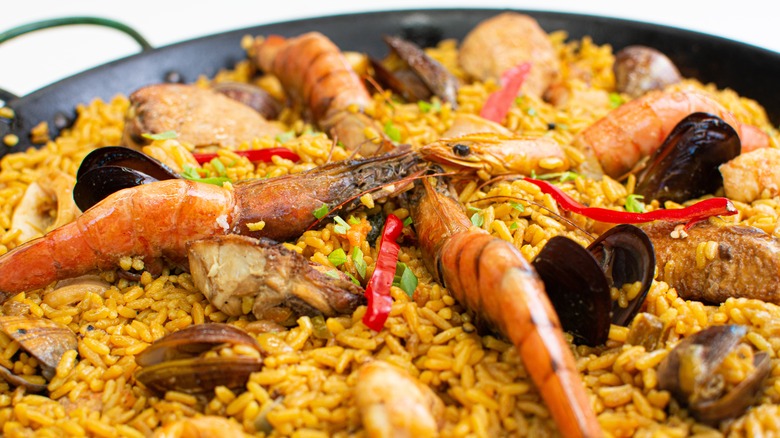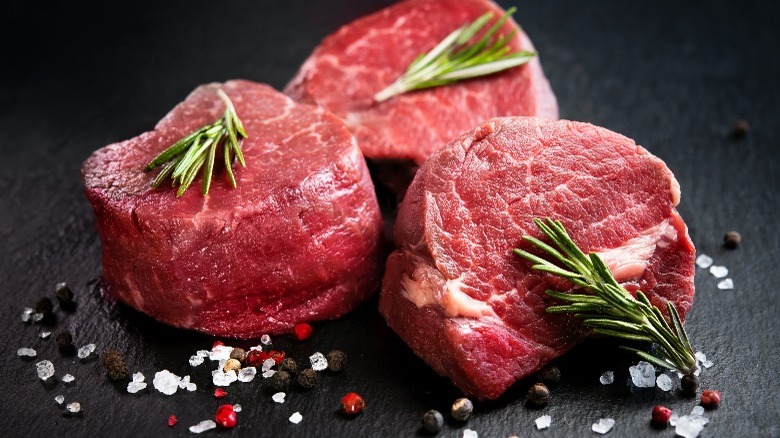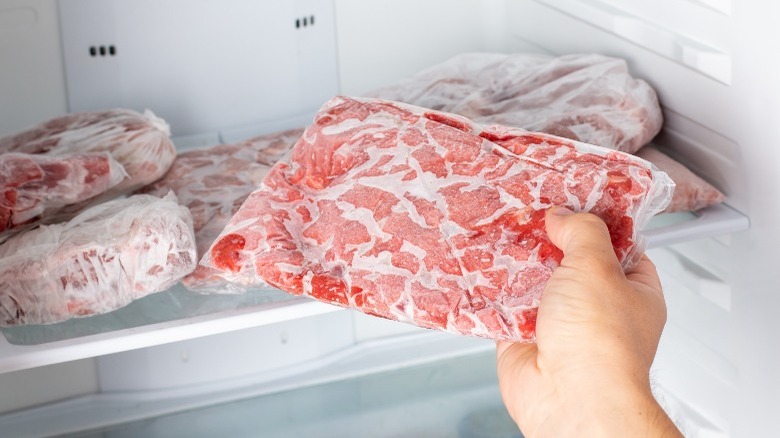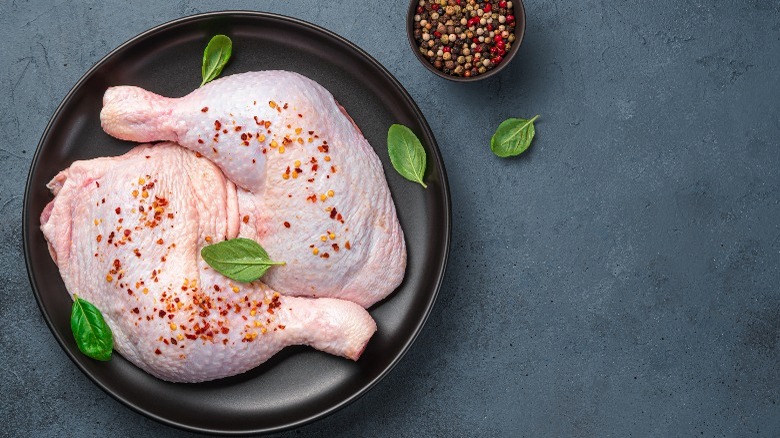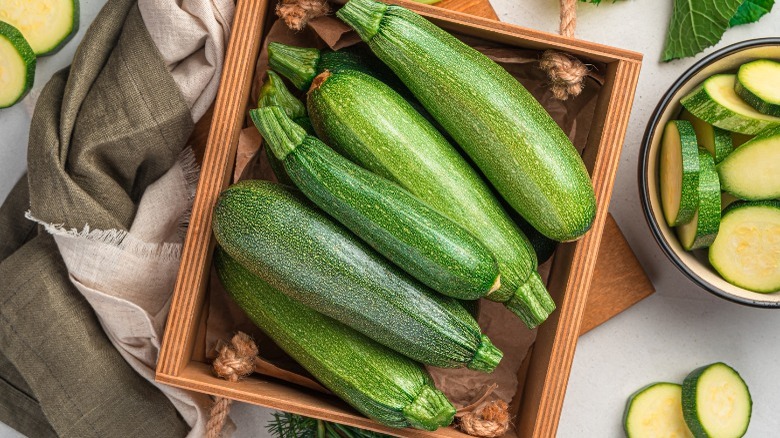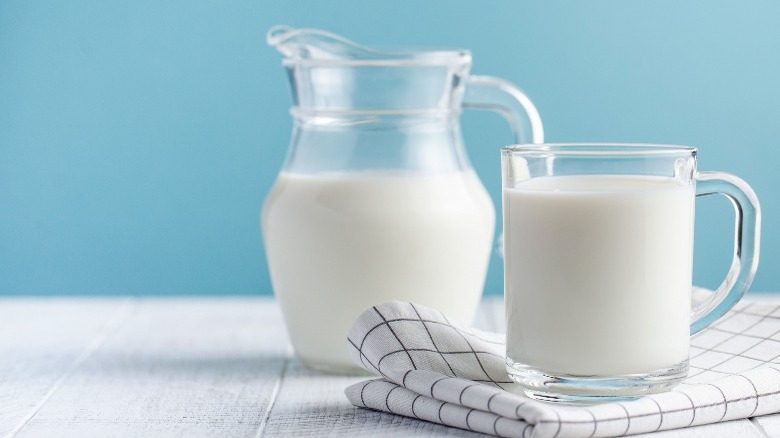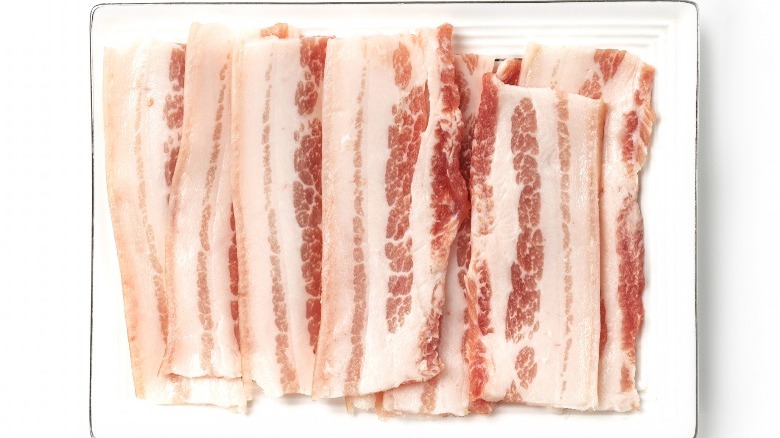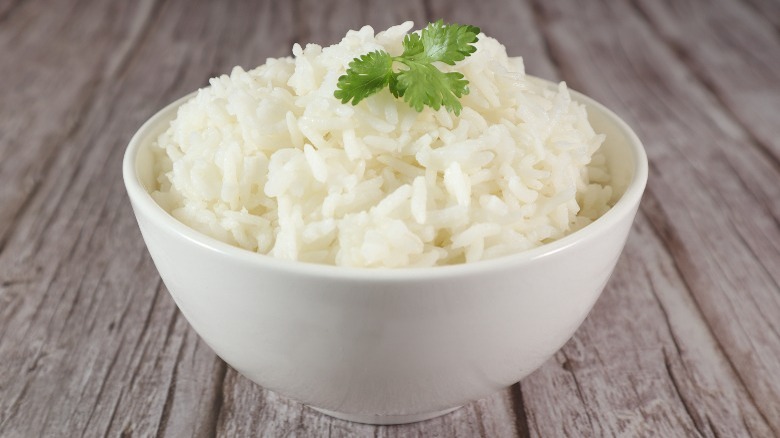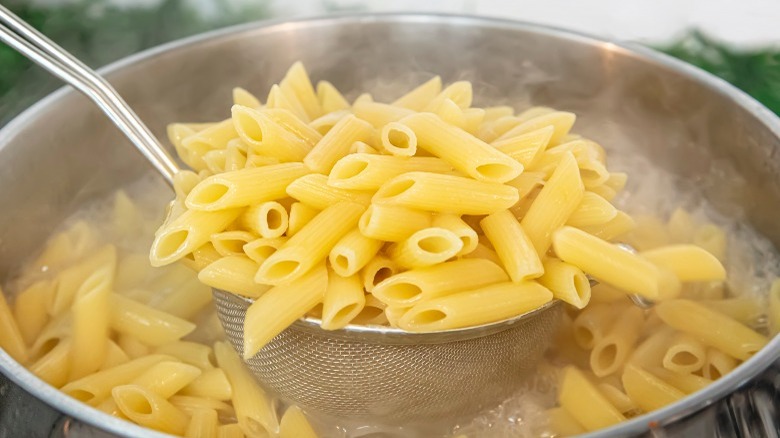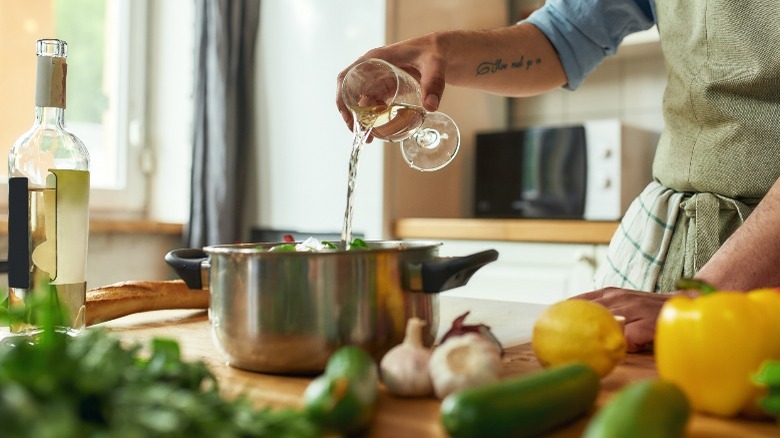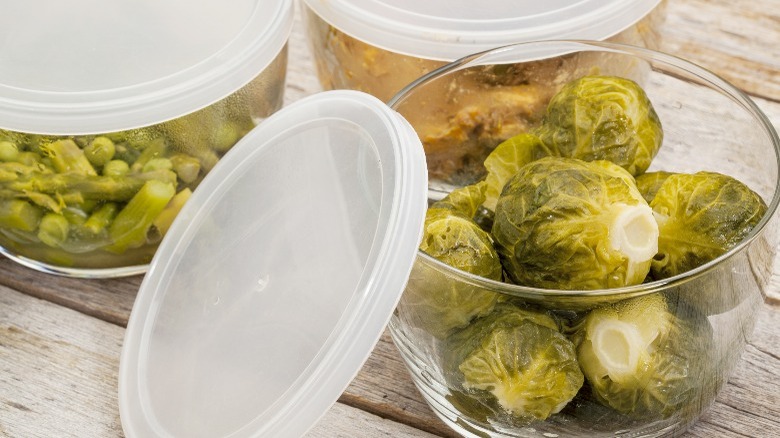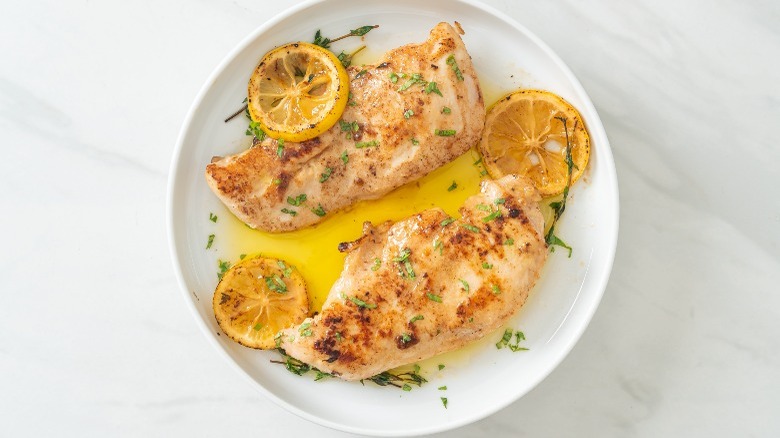12 Foods That Aren't Ideal For Slow Cooking
Before the quick-cooking air fryer and the time-saving instant pot, one kitchen appliance outperformed the rest. No, we're not talking about the microwave or toaster. We're talking about the slow-cooking mean machine that makes you dinner while you're at work all day.
The humble slow cooker is best known for its ability to invite you into the heart of your home as appetizing aromas fill your walls. With minimal effort and basically no supervision, your slow cooker will deliver an enticing, fork-tender meal (almost) every time.
We say "almost" because, like most things in life, there are a few caveats to slow cooking— some foods simply aren't ideal for this method. Some ingredients are far too delicate for long hot cooking times, while others may actually be unsafe to consume when cooked this way. Most of the time, it's a matter of maintaining a palatable texture in foods, and the moist heat will, unfortunately, ruin certain ingredients.
To get the most out of your favorite kitchen appliance, you'll want to avoid adding specific foods or opt to add some ingredients toward the end of the cooking process. Following these guidelines will help save the valuable texture of some foods and give you the best outcome in others.
Fish and seafood
There's a well-known saying in the slow cooking world, "set it and forget it," and it's one of the popular reasons we choose to use the slow cooker appliance. After prepping your meal, you dump the ingredients in, press a button, and then leave for the day. Unfortunately, that doesn't work for fish and seafood.
You shouldn't cook fish (or seafood) in a slow cooker, especially if you plan to walk away from the device for a few hours, because they are extremely lean types of protein that cook fast compared to other meats. So sitting in a hot broth from morning to afternoon is a no-go.
If you have ever sautéed shrimp in a skillet, you probably noticed it turn from a grayish tint to a bright orange-pink hue in just minutes. That's your cue that the shrimp is fully cooked and ready to enjoy. Now imagine letting that shrimp (or any fish or seafood) sit in a slow cooker for hours and hours — slow cooking will undoubtedly cause it to overcook and become unpalatably tough to chew.
There is, however, one way to combat this unfortunate occurrence so you can still use the slow cooker and create a tender meal: Add the fish or seafood towards the end of the cooking time. This slow cooker seafood chowder is an excellent example of how to add mixed seafood for the last 30 minutes after the rest of the dish has already cooked for four hours.
Expensive cuts of steak
If the petite filet mignon tends to be your go-to order at your favorite steakhouse, you might think that same oh-so-tender steak will melt in your mouth after being slow-cooked. While it is possible to throw it in the crock pot, there are a few other cuts that taste even better. The best part? They tend to be much cheaper.
So, save your favorite expensive cuts of beef for a quick sear or over a flame-kissed grill. As for slow cooking, look for cheap stuff. Inexpensive cuts of meat are an excellent choice for slow cooking; in fact, it is one of the only methods that make those cuts worth buying. The reason cheaper steaks do well in the slow cooker is thanks to all that connective tissue and fat content.
When you use a slow cooker, the large vessel is typically filled with a liquid (like broth) which means the device is technically braising the meat. This cooking method will help encourage the breakdown of those tough connective tissues, leaving you with a fork-tender and succulent meal. If you were to grill that same piece of cheap meat, you'd be left with an overly chewy steak that no amount of steak sauce can help.
Frozen meat
If you love meal prepping for your busy week, you probably also appreciate appliances like the slow cooker or instant pot. Buying meat and vegetables in bulk, then creating delicious meals for the week (or month) ensures several home-cooked meals in the future and saves lots of time.
Once you wash and chop up your vegetables and meat, all that's left to do is place it in a large freezer bag, label it and send it off to the ole reliable icebox. However, if your meal-prepping steps land your Ziplock-packed baggies in the freezer, you'll need to thaw that meat before placing it in the slow cooker.
While the slow cooker offers many advantages, you should never put frozen meat in it. Unfortunately, this is a circumstance where the slow cooker's ability to cook food gently works a little too slowly. Since meat spends a lot of time thawing in warm temperatures, it has a lot of opportunity to reach dangerous temperatures where bacteria multiply.
When cooking meat, you want to minimize the time it sits in the danger zone, which falls between 40 F and 140 F. The longer it stays within the temperature range, the more opportunity the bacteria have to multiply and can make you sick. That's a dangerous cooking mistake you don't want to make.
Meat with skin left on
Let's get real here for a second. A well-cooked piece of chicken is good, but it can be better than "good" when done right. We've all had chicken that was overcooked or under-seasoned, but we've also had poultry meal that makes us go, "wow, that's good," and it's usually thanks to that oh-so-crispy skin.
Nothing quite beats the feeling of your teeth sinking into a succulent piece of meat that is perfectly seasoned and crisp on the outside. That crispy chicken skin, which boasts all the rubbed-on seasoning, is ambrosial for your tastebuds, but wait; there's more. The crackling crunch you hear in each bite is critical in the multi-sensory satisfaction of eating something so good. You get the point.
Here's the deal, though. Your slow cooker will ruin that. Skin-on chicken needs to be dry and cooked at high heat to reach its irresistibly crispy exterior. The slow cooker will literally do the opposite. While warming up at a low and slow temperature, all the moisture within the pot will turn that skin into a soggy, chewy mess. Yuck.
Consider removing the skin if you are adamant about using the crockpot for cooking your chicken. Not only will you avoid rubbery, wet skin, but you'll still have a tender and yummy meal to eat. It just won't be as yummy as chicken with crispy skin.
Delicate green vegetables
With all that pork, beef, and chicken you plan on slow cooking, you'll need some nutritious vegetables to help round out that hearty meal. Sadly though, to save on precious texture, you shouldn't cook delicate green vegetables in a slow cooker for too long.
Delicate green vegetables like zucchini, asparagus, and broccoli all cook quickly and turn to mush if they sit in a hot liquid for hours. Peas, green beans, and summer squash will all fall apart, too. This is especially true for leafy greens like spinach, kale, and bok choy. Because they cook up so quickly, you'll ruin your meal's texture and overall experience with long cooking times.
But considering that some meals aren't the same without certain veggies (you can't have beef and broccoli without the broccoli), you can defeat the issue by adding them towards the end. For example, after the sturdier ingredients (like meat) have cooked for a few hours in the broth, you can add your broccoli for the last 20 minutes. Leafy greens should be added to the pot during the cooking process's last few minutes.
Otherwise, we recommend you make meals that call for hearty vegetables that hold their structure better. Potatoes, carrots, parsnips, mushrooms, celery, and onion keep their shape and taste delicious even after several hours of slow cooking.
Dairy
It's not so much that you can't add dairy to a slow cooker, but more so that you can't let most dairy products cook for hours in it. We know you're probably thinking about your famous slow cooker macaroni and cheese recipe you have been making for years. Or maybe it is the broccoli potato cheese soup you love that's making you a little unconvinced here. But have you ever paid attention to when a recipe calls for adding in milk, cream, or cheese?
Putting cream, milk, or cheese right at the beginning of the slow cooking process can cause it to curdle or separate. Since you aren't making cheese, curdling will only cause an unpleasant mouthfeel to a (what should be) creamy and oh-so-cheesy meal. Evaporated milk is the one exception to this rule, so if you see a slow cooker recipe that calls for this ingredient, you don't have to worry about curdling.
The only thing you need to do differently is to add those creamy dairy ingredients toward the end if you need to cook your meal for several hours. Otherwise, meals with shorter cooking times usually won't cause separation.
Bacon
Oh, the joys of perfectly crisp bacon. When fried just right, the corner ends will melt in your mouth. To experience such savory happiness, dancing on your tastebuds is a great way to start your day or end it. Bacon is good any time of the day.
Compared to the mediocrity of other cured meats, there's no winning against succulent slices of salty bacon. However, you'll ruin such a beautiful fatty masterpiece with the help of slow cooking. Even though most fatty meats (like pork butt and chuck roasts) typically cook wonderfully in the slow cooker, bacon works differently.
You shouldn't cook bacon in a slow cooker because it is far too thin and tastes best when fried quickly to a crisp texture. While there are several tried-and-true methods to cooking bacon perfectly, you won't find the slow cooker recommended at any time. That's because the moist heat will turn it into a soggy and soft consistency.
However, if you are making baked potato soup in your favorite appliance and want bacon, you can still make it happen. Cook it separately, add it towards the end, or add it right on top of your meal as a crunchy garnish. You will get to enjoy the best of both worlds — a delicious hot soup, with crispy bacon bits on top.
Rice
From not washing excess starches to stirring those precious grains when you shouldn't, there are so many mistakes everyone makes when cooking rice. Assuming you can cook all varieties of rice exactly the same way is another big blunder we want people to stop doing, too.
Arborio rice is best known for making a creamy risotto that needs constant stirring, while basmati rice, widely relished for its enticing aroma, cooks differently over a stovetop and should not be disturbed during the cooking process. There really isn't a great grain that holds well when it comes to slow cooking for several hours, though.
While making a big batch of rice in your slow cooker is an excellent use of your appliance, adding it to other recipes is where you might run into mushy results. This is especially true for quick-cooking instant rice. If the soft overcooked rice texture doesn't bother you (some people like it that way), then feel free to throw it in at the beginning of your recipe. Otherwise, we recommend cooking the rice separately and then adding it to the crockpot right before serving, pouring your meal over a bed of already-cooked rice.
Pasta
We don't want to completely diss the idea of cooking pasta in a slow cooker, but it's really not our preferred method of cooking it for the best results. The reason you shouldn't cook pasta in a slow cooker is that pasta does best when given attention and cooked in boiling, salted water.
The low heat, trapped steam, and convenience of walking away for hours will not do your pasta any justice. Instead, it will cause it to become too soft and gelatinous. Bringing a pot of water to a boil takes a few minutes, then boiling your pasta to a nice al dente only takes another eight minutes. So, dirtying one extra pot to cook it on the side isn't that much of an inconvenience, if you ask us.
But at the end of a long day at work, we understand you might not want to add any extra effort to cook dinner; after all, the slow cooker was designed to set it and forget it. Like most other foods on this list, there are ways to avoid the mushy disaster, and it's all about timing.
To avoid this mistake when using a slow cooker, add the dried pasta to the slow cooker about 20 minutes or so before it's time to eat.
Alcohol
Cooking with alcohol will improve your meal like no other. Ina Garten will tell you booze is her secret weapon in several dishes. Whether you add cold fizzy beer to marinades through the months of summer, or you like deglazing your pans with the help of a little red wine, you'll learn quickly how the flavor is affected with booze. Here's the thing; in order for alcohol to burn off, you need to cook your meal for a long period of time, but there's another important component to the equation. The alcohol must have a place to evaporate. Alcohol can affect your slow cooker meals because the appliance usually doesn't get hot enough, even with the lid on, for hours on end.
With no place for alcohol to evaporate and escape, you'll really get a strong kick of flavor in your meal. Now, we're not saying you'll get drunk from your slow cooker boeuf bourguignon, but you'll definitely get a strong taste of booze that won't complement your meal the way it is meant to.
One way to still get the most out of your slow cooker meal without ruining it with too much alcoholic taste is by browning whatever meat you're cooking in a separate pan. From there, you can deglaze the pan with the alcohol, then pour it into the slow cooker. Not only will it help cook off the booze, but you'll have a chance to enjoy all those delicious brown bits from the deglaze.
Leftovers
You already know putting frozen foods in the slow cooker can be unsafe. Because of low and slow cooking times, those frozen foods have a greater chance of sitting in the temperature danger zone for too long, which can lead to foodborne illness.
Cold leftover foods work similarly. Just like frozen meat, you also want to avoid putting leftovers in a slow cooker as they can be unsafe to consume. Since the slow cooker won't reach hot enough temperatures quickly enough, your leftovers will have a greater chance of sitting in that dangerous range of between 40 and 140 F for too long. Instead of using a slow cooker, consider using the microwave, oven, or air fryer instead.
Keep in mind reheating leftovers more than once can also be unsafe. Frequently reheating foods and changing the temperature provide additional opportunities to reach that danger zone and will diminish the quality of your meal. Plus, if you plan to reheat leftovers, you'll need to ensure it reaches 165 F each time you do, (per USDA). If you don't plan to eat the entire large batch of leftovers, consider only reheating what you plan to eat.
Chicken breast
Chicken breasts are a great go-to when you need to get dinner on the table quickly, but they aren't the best for your slow cooker. Unfortunately, because they are so lean, they are likely to dry out with long cooking times.
Plenty of slow cooker recipes call for chicken breasts, and you are more than welcome to try them if you prefer white meat over dark. In fact, recipes like chicken tortilla soup or shredded barbecue chicken will do well thanks to the added liquid, which can help bring back some of the juicy savors.
For more succulent results, opt for chicken thighs. Not only do they take a little bit longer to cook, but they won't dry out as chicken breasts do. The bone-in chicken will always boast juicy results too, so if you don't mind working around them, we say go for bone-in. If you have chicken breasts that you need to cook up, consider searing them in a skillet and then finishing them off in the oven, instead.
